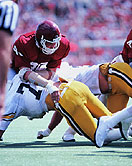
THURSDAY, July 12 (HealthDay News) — Concussions among football players at three U.S. service academies have increased since 2009, according to a new study.
The increase comes after a 2010 National Collegiate Athletic Association concussion-management initiative that required athletic programs to report concussion signs and symptoms, and then take players who exhibited the symptoms out of the game.
Study authors led by Dr. Kelly Kilcoyne, of the Walter Reed National Military Medical Center, analyzed data from practices and games at the United States Military Academy, United States Naval Academy and the United States Air Force Academy. All players were males aged 18 to 22.
The total number of reported concussions increased from 23 during the 2009-10 season to 42 during the 2010-11 season.
The study was scheduled to be presented Thursday at the American Orthopaedic Society for Sports Medicine annual meeting, in Baltimore.
“The timing of the new NCAA regulations and the increase in reported concussions could certainly be attributed to under-reporting from players and coaches in the past,” Kilcoyne said in a society news release. “[But] such an increase is still notable, and we need continued studies in football and other sports to find out more.”
Dr. Robert Glatter, an emergency medicine physician at Lenox Hill Hospital in New York City, agreed.
“The degree of increase in reported rates is concerning, and will require larger well-controlled studies to evaluate the increased concussion rates observed in this limited study,” he said. “What is clear is that many players have experienced a number of concussions prior to participation in collegiate athletic programs, and that some have already received undertreatment … for their head trauma when they begin their college athletic careers.”
Top-of-helmet impacts are particularly dangerous ways of stopping an opponent, Glatter said, yet these types of hits often are learned in youth leagues or high school athletic programs as a result of improper coaching.
“Other factors potentially leading to higher concussion rates could be due to lack of proper conditioning to withstand hits, and poor conditioning of [neck] muscles in college athletic programs,” he added.
Children and young adults are especially vulnerable. “Their brains continue to develop in their early 20s, and research has shown that younger athletes, all other factors being equal, will typically require more time to recover from concussions than their adult counterparts,” Glatter said.
“If they sustain head trauma or concussions in their late teens and early 20s, the window for repetitive injury is lengthened,” he said. “The long-term complications of repetitive head trauma can have lasting effects on younger athletes into their adult years.”
Recognizing the symptoms of concussions and seeking prompt medical attention is key. Symptoms may include nausea, dizziness, headache and disorientation, Glatter said. Symptoms can appear immediately after a head injury, or develop over days after the blow.
In the past, concussions weren’t taken seriously enough, said Dr. Jordan Metzl, a sports medicine doctor at the Hospital for Special Surgery in New York City.
“We didn’t treat concussions with adequate respect and seriousness,” he said. An increase in awareness about the long- and short-term consequences of concussions has led to more diagnoses. Still, “every time somebody hits their head, it’s not a concussion,” he said.
If someone does sustain a concussion, they need to be taken out of the game right away. The best way to treat a concussion is to rest the brain, he said.
Because this study was presented at a medical meeting, the data and conclusions should be viewed as preliminary until published in a peer-reviewed journal.
More information
Learn more about the signs and symptoms of concussions at the STOP Sports Injuries campaign.

